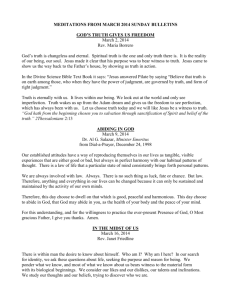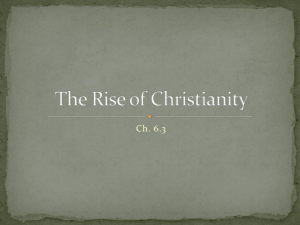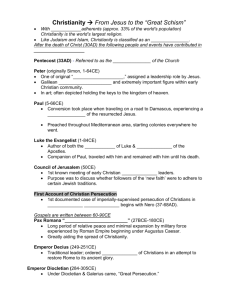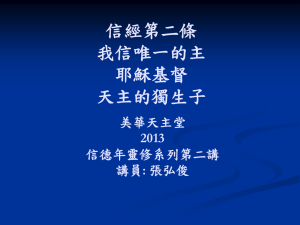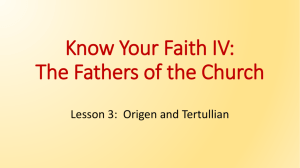Response to Mona Siddiqui by dr. Harm Goris
advertisement
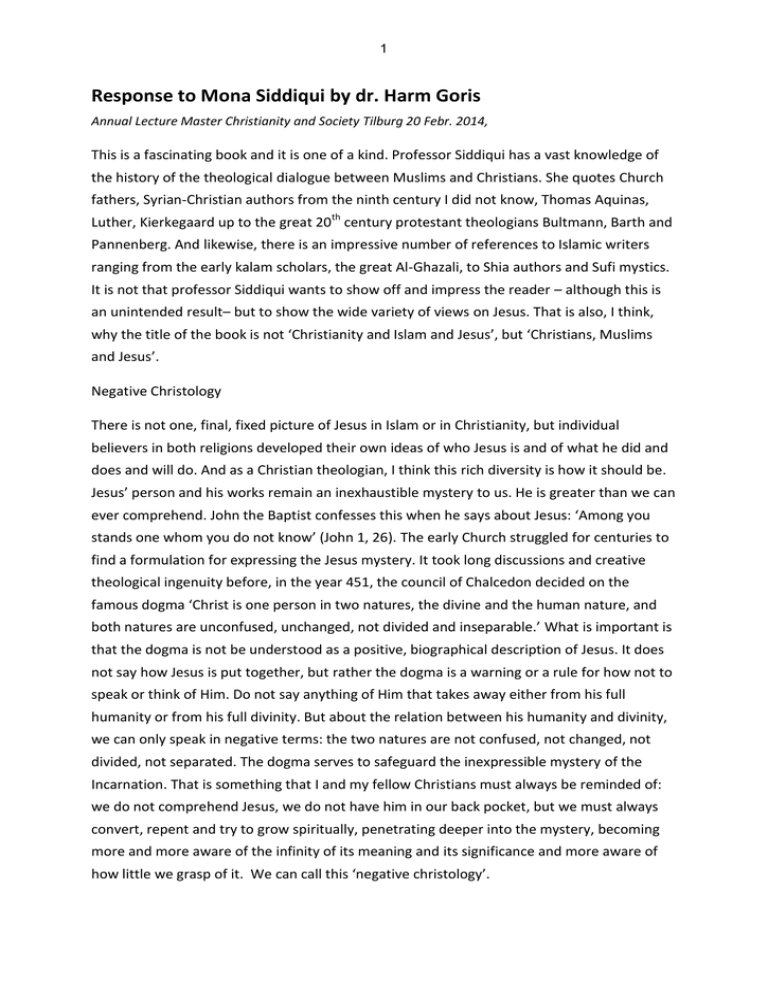
1 Response to Mona Siddiqui by dr. Harm Goris Annual Lecture Master Christianity and Society Tilburg 20 Febr. 2014, This is a fascinating book and it is one of a kind. Professor Siddiqui has a vast knowledge of the history of the theological dialogue between Muslims and Christians. She quotes Church fathers, Syrian-Christian authors from the ninth century I did not know, Thomas Aquinas, Luther, Kierkegaard up to the great 20th century protestant theologians Bultmann, Barth and Pannenberg. And likewise, there is an impressive number of references to Islamic writers ranging from the early kalam scholars, the great Al-Ghazali, to Shia authors and Sufi mystics. It is not that professor Siddiqui wants to show off and impress the reader – although this is an unintended result– but to show the wide variety of views on Jesus. That is also, I think, why the title of the book is not ‘Christianity and Islam and Jesus’, but ‘Christians, Muslims and Jesus’. Negative Christology There is not one, final, fixed picture of Jesus in Islam or in Christianity, but individual believers in both religions developed their own ideas of who Jesus is and of what he did and does and will do. And as a Christian theologian, I think this rich diversity is how it should be. Jesus’ person and his works remain an inexhaustible mystery to us. He is greater than we can ever comprehend. John the Baptist confesses this when he says about Jesus: ‘Among you stands one whom you do not know’ (John 1, 26). The early Church struggled for centuries to find a formulation for expressing the Jesus mystery. It took long discussions and creative theological ingenuity before, in the year 451, the council of Chalcedon decided on the famous dogma ‘Christ is one person in two natures, the divine and the human nature, and both natures are unconfused, unchanged, not divided and inseparable.’ What is important is that the dogma is not be understood as a positive, biographical description of Jesus. It does not say how Jesus is put together, but rather the dogma is a warning or a rule for how not to speak or think of Him. Do not say anything of Him that takes away either from his full humanity or from his full divinity. But about the relation between his humanity and divinity, we can only speak in negative terms: the two natures are not confused, not changed, not divided, not separated. The dogma serves to safeguard the inexpressible mystery of the Incarnation. That is something that I and my fellow Christians must always be reminded of: we do not comprehend Jesus, we do not have him in our back pocket, but we must always convert, repent and try to grow spiritually, penetrating deeper into the mystery, becoming more and more aware of the infinity of its meaning and its significance and more aware of how little we grasp of it. We can call this ‘negative christology’. 2 Revelation The incarnation, the Eternal Word of God becoming man and sharing our fate till death, belongs to the heart of the Christian gospel. It also involves a different understanding of what revelation means. In her book, prof. Siddiqui states that the concept of revelation in Islam and in Christianity is one of the key differences between the two religions. “The fundamental issue, however, remained that for the purpose of Islamic prophecy, revelation appears but divine distance is maintained. For Christians, in the Incarnation, God is revealed and the distance is overcome’ (pp. 147-48). And again, on p. 221: ‘In Christianity and Islam the modes of God’s disclosure are dramatically different.’ And she is right. For Christianity, basically, divine revelation does not consist in God telling us something. It is not so much that God gives us information or instruction, that he communicates messages to us. No, revelation means that God gives Himself to us. For Christianity, divine revelation is God’s self-communication to humankind. He does so by sending the eternal divine Word and the eternal Holy Spirit into history. The Word becomes human in Jesus and the Holy Spirit is given to the Church and poured out into the hearts of the believers. These two missions of the Word and of the Spirit constitute so to say the infrastructure of God’s revelation and are the backbone of salvation history. That God has become present to humans for their wellbeing and their flourishing with such an unthought-of and unheard of nearness, is what motivated Christians to develop the doctrines of the Trinity and of the two natures of Christ. By God’s self-gift, the distance between Creator and creature, between God and human beings, is indeed overcome, as prof. Siddiqui says. Distinction God – creatures However, for Christians this does not mean that the distinction between the two is nullified. True, in the Bible, 2 Peter 1,4 it is said that we “may become partakers of the divine nature”. And the theology of the eastern church focuses very much on the topic of our ‘deification’ or ‘divinization’, that means, that we become divine through the transformation that God’s nearness brings about in us. However, such language should not be understood as if the distinction between Creator and creature is removed, as if we are dissolved in the ocean of God’s unity. The question is then: how to articulate the distinction between God and creature. How does God differ from human beings? In her book, Professor Siddiqui points out that the very same question has also occupied Muslim scholars from the very beginning, and she refers to ‘the perennial tanzih-tashbih debates’. How to think together God’s transcendence and his immanence? In Islam, God is the sovereign Lord of all, yet he is also closer to man than his jugular vein, as the Qur’an says (50,16). Christian theologians were confronted with similar paradoxes, and so it seems, even more urgently. For it is not only the 3 question of how the transcendent God is present to all of creation, but moreover, how God is present in a truly new and different way to his adopted children, to those who know and love Him. And, on top of that, the question of how God is present in a unique, singular way in Jesus Christ. These three ways of divine presence, as Creator in everything, as known and loved in the believers, and as person in Christ, differ qualitatively; it is not just a matter of gradually less and more, but of fundamentally new modes of divine presence in the world. I think that Muslim and Christian theologians can help each other in finding words for expressing the distinction between God and the non-divine, the creature. This is not an easy task. After all, we are only familiar with distinctions and differences within created reality. And there we can discern different types of differences. This chair differs from that chair, that is one kind of difference. But it also differs from a desk, which again is another type of difference. And the chair differs from me, from the Milky Way; the chair also differs from the battle of Waterloo and from the number 12. These are all distinct kinds of differences, but however disparate, these differences have one thing in common. In one way they are similar, for they all indicate differences between creatures and hold within created reality. The difference between God and creatures is of a totally other nature. It is a difference of its own kind. As my colleague Henk Schoot has phrased it: God differs differently. I think that a shared effort of Muslim and Christian theologians can help us all to become more aware of the unicity of this distinction and find ways how to formulate it. Such a joint enterprise of Muslim-Christian dialogue in dealing with the same religious question can also contribute to a better mutual understanding of the differences between us. I think here especially about what it means for Christians to become transformed, recreated, through God’s grace and to participate in God’s self-knowledge and self-love and what it means for Christians to profess that Christ is fully human and fully divine. Human transformation Professor Siddiqui correctly points out that the Christological debate between Muslims and Christians is not an isolated topic. It is intrinsically connected to views on what human beings are and to what end God has called them. Christians believe that in Christ and through the Holy Spirit, they are in the process of being transformed, of being recreated into new persons. Christ’s crucifixion and resurrection and the gift of the Holy Spirit are the decisive eschatological events. According to Christianity, the eschaton, i.e. the final realization of God’s intention for humanity from all eternity, or what Jesus called ‘the Kingdom of God’, is not solely something future, but it is already beginning to open here and now. In Christianity, God has not ordained us for returning to Paradise, to the pristine status of creation, but for something much more and higher. It is the participation in the divine nature, the deification 4 of human beings. In traditional Catholic language, this is called the supernatural end of the beatific vision. We are destined for a loving communion with God, for seeing Him face-toface. As Paul says in the first letter to the Corinthians: ‘For now we see in a mirror, dimly, but then we will see face to face. Now I know only in part; then I will know fully, even as I have been fully known.’ Although that final, eternal vision is not of this world, but is hoped for in the future world, there is already a beginning here and now: we see dimly in a mirror and know in part, says Paul. This eschatological, supernatural transformation of human beings is what Professor Siddiqui finds difficult or even impossible to follow. As she writes: “I am not sure that I see the complexities of this theology as meaningful in my life. I don't understand the radical nature of this love which makes God man and man God […] I also know that I must go to him eventually, that he has not already come, the descent of the sublime” (246). Maybe Christians don’t understand it very well either, that’s why they keep talking about it and writing complex theological volumes. But somehow this transformation is a reality in their lives. And it is also from the reality of somehow being saved and recreated by God, that they look backward and develop stories about the Fall, original sin and about humanity being lost by sin. It is very important to keep that order straight. We have to start with being saved by God and from there by way of contrast understand our previous condition. We should not reason the other way around, although this has often been done in Christian theology and preaching. We should not start with the observation how wicked people are and then conclude that Christ must come and must die in order to overcome our wretchedness. The right perspective is the reverse. Professor Siddiqui writes that she cannot understand ‘why the Fall becomes the paradigm of human life, making the cross the ultimate paradox of death and new life’ (242-243). My point is that in true Christianity the Fall is not the paradigm of human life, but the new life in Christ and the Spirit is. The final chapter of the book is very personal. Prof. Siddiqui writes that in Islam, ‘the vocabulary of God’s nearness is radically different because there is always a separation between God and man. But this separation is in doctrine only, not in experience. The absence of the cross does not diminish divine love, it is replaced by a different longing for God. I have a copy of the Qur’an always at my bedside table. I try to read at least a couple of lines before I leave the house every day. I do not see God physically in this reading but I feel this presence. To feel God’s gaze in this action is powerful, consoling, even moving’ (p. 245). A few pages before, Mona explains that in her experience as a Muslim the separation from God is always overcome through his mercy, his compassion. To know and to trust that we can always return to him when we have gone astray and that he will always mercifully welcome us, is what I would call the faith that saves.

